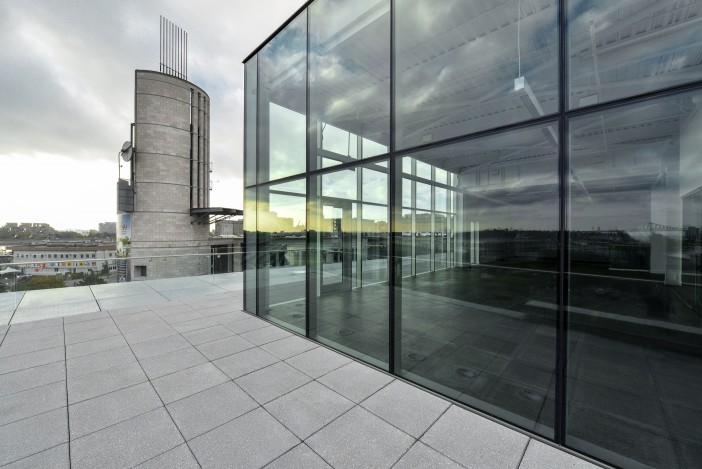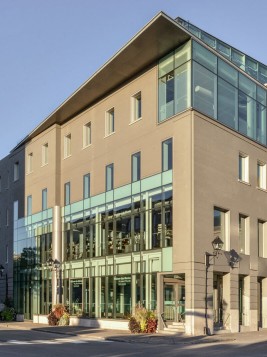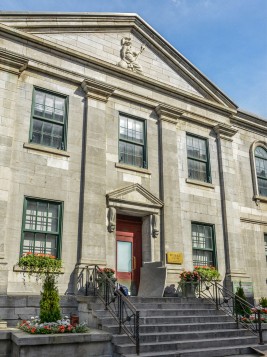Places and buildings
The Mariners’ House: anchored in history
The Mariners’ House rises majestically in the heart of Old Montréal, at the corner of Place D’Youville and Place Royale. The building has served numerous functions since it first went up. Today, this Pointe-à-Callière fifth pavilion is harmoniously integrated into the historic district, for the pleasure of its visitors.
Built for mariners
Let’s go back in time... Starting in 1875 and for close to sixty years, the Montreal Sailors’ Institute stood on this corner, welcoming merchant sailors stopping in Montréal. But the port became busier over the years and more and more sailors were arriving, so by 1940 the building had become rather cramped. During the Second World War, the Board of Directors commissioned architect C. R. Titley to draw up plans for a new building which went up over the next two years.
There is a commemorative plaque dated 1953 on the building. But records show that the Montreal Sailors’ Institute was officially inaugurated in 1954 by Lionel Chevrier, federal Transport Minister at the time, and Montréal Mayor Camillien Houde. Hundreds of thousands of sailors passed through the building over the years. They had access to lounges and games rooms, a chapel, a concert hall, left luggage, a post office, currency exchange, a barber shop and doctor’s office, not to mention a cafeteria and beds. In 1968, the Montreal Sailors’ Institute merged with the Catholic Sailors’ Club to create the Mariners House.
In 1987, the Œuvres de la Maison du Père purchased the building to serve as a men’s shelter, renovating and renaming it the “Résidence du Vieux-Port.” The shelter was inaugurated in 1988 by Montréal Cardinal Paul Grégoire and remained in operation until 2004.
A new gathering place
In 2004, through the Pointe-à-Callière Foundation, the Museum purchased the building and began using it for school groups. In 2011, the building was included in Pointe-à-Callière’s expansion plans, aimed at creating the Montréal Archaeology and History Complex. The building was refurbished by Dan S. Hanganu and Provencher Roy + Associés Architectes, the same consortium responsible in 1992 for the main Museum building (the Éperon), and the archaeological crypt beneath Place Royale. The building is now named the “Mariners’ House” as a nod to its history.
A contemporary project built on traces from the past
The architects decided to make Pointe-à-Callière’s fifth building a contemporary project with an urban flavour so that it would blend seamlessly with the Museum’s Éperon building and the rest of the neighbourhood. They also chose to showcase the archaeological finds and history in the building’s basement. The façade on Place D’Youville incorporates a two-storey glass curtain wall that floods the building with light and creates a sense of transparency. The lobby gives onto a monumental staircase with an original creation by Montréal artist Nicolas Baier, and also features a multimedia installation designed by Moment Factory, a Montréal firm. The window-lined spaces on Floors 3 and 4 offer superb views of the Old Port, the St. Lawrence River and Old Montréal.
Architecture that combines the seafaring past with the present
The Mariners’ House is strategically located along the visitor tour route through the Museum, set between two public squares that have witnessed so much of the city’s history: Place D’Youville and Place Royale.
What makes the site so special is that it is set in the heart of the 18th-century historic district, at the confluence of the St. Lawrence River, the former Little St. Pierre River and the William collector sewer. The building’s architecture and the way it blends in are at once a salute to the building’s past and a tribute to its modern face as part of the historic district, just as the Éperon building is now recognized as one of the city’s most striking landmarks.
Accessible architecture for a new, popular gathering place
The architects designed the new building to be accessible by day, visible by night and pleasant to visit and use year round. This new centre devoted to history and archaeology allows the Museum to continue hosting major exhibitions, lectures and special events, in addition to housing a unique education space, the Archaeo-Adventure workshop, with its simulated archaeological digs.
On November 1st, 2013, the National Bank made an exceptional donation to the Pointe-à-Callière Foundation. Aware of the importance to protect and promote buildings and traces of Montréal’s past, the National Bank emphasizes its commitment to history by associating its name to the Mariner’s House which is now named Mariner’s House – National Bank Pavilion.



